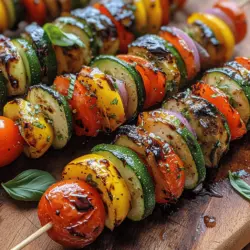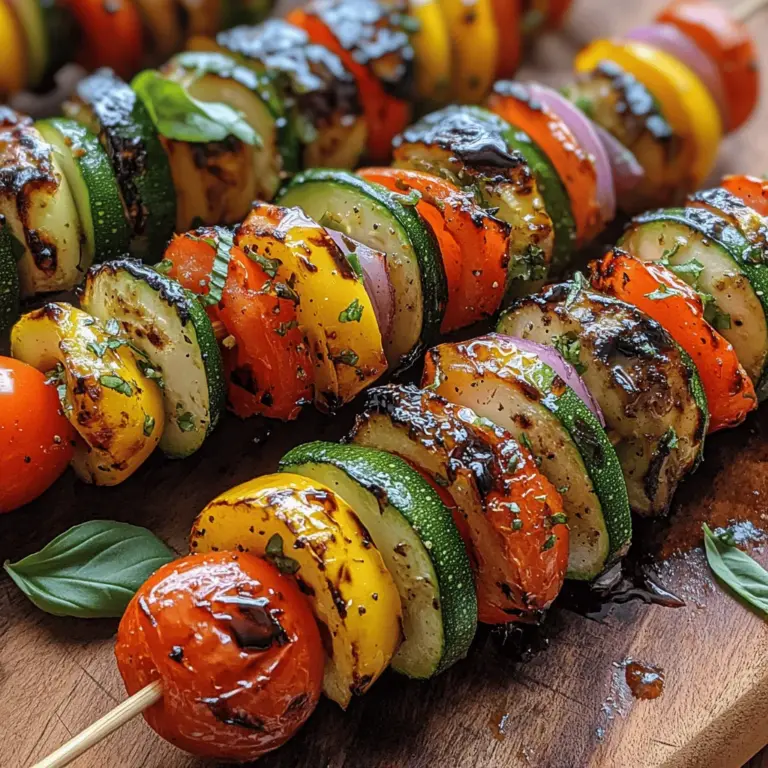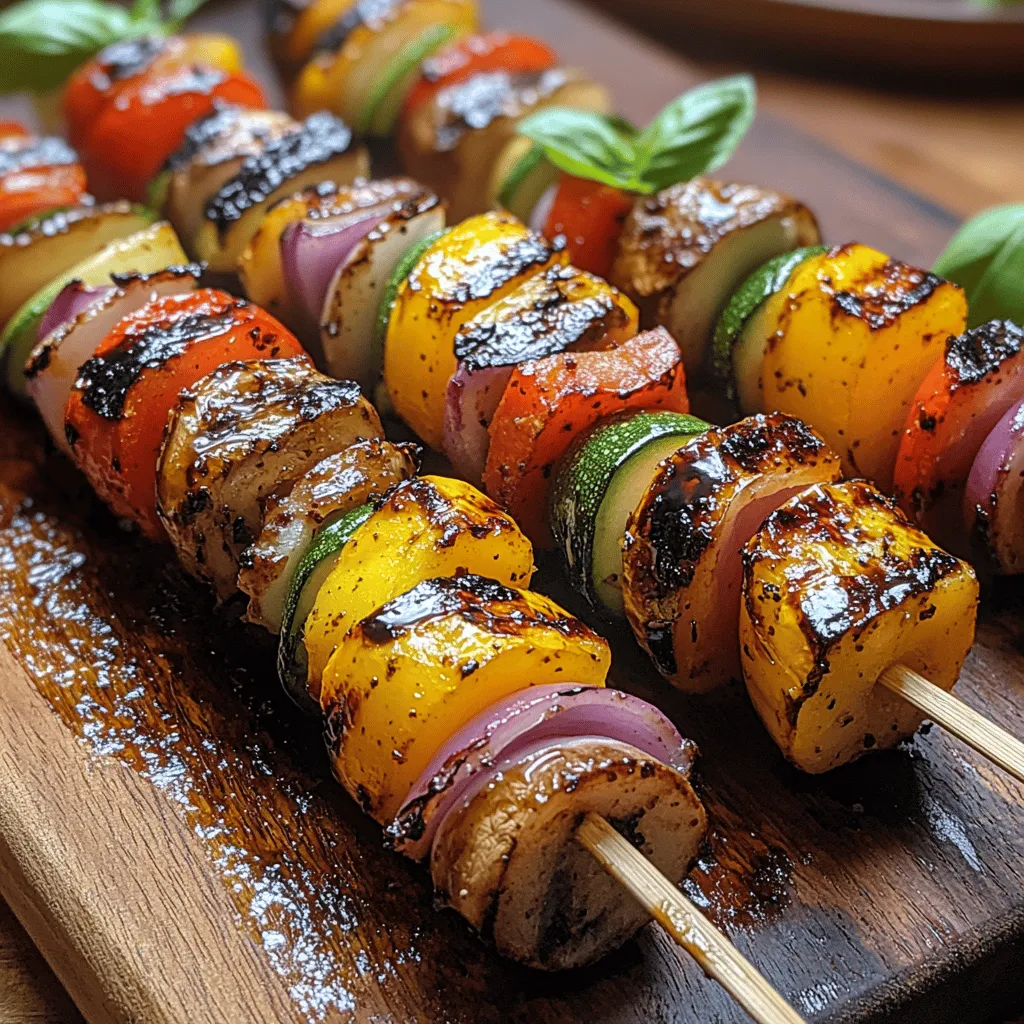Introduction
If you’re searching for a dish that bursts with color, flavor, and health benefits, look no further than colorful grilled veggie kabobs with balsamic glaze. This delightful recipe not only showcases a vibrant array of vegetables but also embodies the essence of modern cooking—where health and taste go hand in hand. In a world increasingly focused on nutrition, these kabobs offer a satisfying way to incorporate a variety of vegetables into your meals, making them perfect for health-conscious individuals and families alike.
Grilled veggie kabobs are particularly appealing because of their versatility. Whether you follow a vegetarian, vegan, gluten-free, or even a paleo diet, these kabobs can be easily modified to suit your dietary preferences. The combination of fresh vegetables, a rich balsamic glaze, and the char from grilling creates a dish that’s not only visually stunning but also packed with nutrients. This recipe invites creativity; feel free to swap in your favorite seasonal vegetables or add different herbs to elevate the flavors.
The Benefits of Grilling Vegetables
Grilling vegetables is not just a cooking method; it’s an art that brings out the best in seasonal produce. One of the primary benefits of grilling is the enhancement of flavor and texture. The high heat of the grill caramelizes the natural sugars found in vegetables, resulting in a sweet, smoky flavor that is hard to replicate with other cooking methods. This process adds depth and complexity to your kabobs, making them irresistible.
Nutritionally, grilled vegetables are a powerhouse. Grilling helps retain the vitamins and minerals in vegetables, making them a healthy addition to your meals. For instance, vegetables like zucchini and bell peppers are high in antioxidants, which can help reduce inflammation and promote overall health. By choosing to grill instead of fry or sauté, you minimize added fats and calories while maximizing flavor.
Furthermore, grilling often evokes a sense of community and outdoor cooking, making it a staple during summer barbecues and family gatherings. The act of gathering around the grill creates an opportunity for shared experiences, laughter, and delicious food, emphasizing the joy of cooking and dining together.
Choosing the Right Vegetables for Kabobs
The beauty of grilled veggie kabobs lies in their ability to showcase a variety of vegetables. While the recipe primarily features zucchini, bell peppers, red onions, cherry tomatoes, and mushrooms, you can easily customize your kabobs based on seasonal availability and personal preference.
Zucchini
Zucchini is a staple in many grilled vegetable recipes, and for good reason. Low in calories and high in water content, zucchini is hydrating and provides a satisfying bite. It’s also a good source of vitamin C and antioxidants, which can support your immune system. When grilled, zucchini takes on a slightly sweet flavor and a tender texture that complements many other vegetables.
Bell Peppers
Bell peppers are perhaps one of the most colorful additions to your kabobs. Available in a range of hues, including red, yellow, green, and orange, they not only add visual appeal but also a wealth of nutrients. Rich in vitamins A and C, bell peppers are known for their health benefits, including improved vision and skin health. Their crunchy texture and slightly sweet taste create a delightful contrast when grilled, enhancing the overall flavor profile of your kabobs.
Red Onion
Adding red onion to your veggie kabobs provides a punch of flavor that elevates the dish. Known for their sharp yet sweet taste, red onions become wonderfully mellow when grilled, adding depth to your kabobs. Additionally, they offer health benefits such as anti-inflammatory properties and a good source of antioxidants. Their vibrant color can also enhance the visual appeal of your dish.
Cherry Tomatoes
Cherry tomatoes are a sweet, juicy burst of flavor that can make any kabob shine. When grilled, they become tender and slightly charred, lending a delightful contrast to the crunchier vegetables. They are also packed with vitamins, particularly vitamin C, and lycopene, an antioxidant that may have health benefits, including heart health and cancer prevention.
Mushrooms
Don’t forget about mushrooms, the umami-rich ingredient that adds a savory depth to your kabobs. Varieties like cremini and portobello are excellent choices, as they hold up well on the grill and absorb marinades beautifully. Mushrooms are low in calories yet high in essential nutrients like selenium, potassium, and vitamin D, making them a smart addition to any healthy meal.
Seasonal Vegetable Suggestions
While the above vegetables form the base of our grilled veggie kabobs, feel free to experiment with seasonal produce. Asparagus, eggplant, zucchini blossoms, or even corn on the cob (cut into smaller pieces) can be delicious additions. This not only enhances the flavor but also makes use of what’s fresh and available, ensuring your kabobs are as flavorful as possible.
Preparing the Vegetables for Grilling
To create perfectly grilled veggie kabobs, proper preparation is key. Here’s a step-by-step guide on how to prepare your vegetables for grilling, ensuring they cook evenly and absorb maximum flavor.
1. Wash and Dry: Begin by washing all your vegetables thoroughly under cold running water. Pat them dry with a clean kitchen towel or paper towel to remove excess moisture. This step is crucial, as excess water can cause steaming instead of grilling.
2. Slicing Techniques: For even cooking, it’s essential to cut your vegetables into similar sizes. Generally, 1-inch pieces work well. Here’s a quick guide:
– Zucchini: Slice into rounds or half-moons for even cooking.
– Bell Peppers: Remove the seeds and cut into 1-inch squares or strips.
– Red Onion: Cut into thick wedges or chunks that will hold together on the skewer.
– Cherry Tomatoes: Leave them whole for a burst of juiciness.
– Mushrooms: If using larger mushrooms, cut them in half or quarters, ensuring they are roughly the same size as the other vegetables.
3. Marinating the Vegetables: Marinating not only enhances the flavor of your kabobs but also helps to tenderize the vegetables. A simple marinade can be made using olive oil, minced garlic, fresh herbs, salt, and pepper. Allow the vegetables to marinate for at least 30 minutes to an hour before grilling. This allows the flavors to seep in and creates a more delicious final dish.
4. Skewering: Once your vegetables are marinated, it’s time to assemble your kabobs. If using wooden skewers, soak them in water for about 30 minutes to prevent burning on the grill. Then, thread the vegetables onto the skewers, alternating colors and types to create a beautiful arrangement. This not only looks appealing but also ensures a variety of flavors in each bite.
By following these steps, you’ll have a colorful and flavorful array of grilled veggie kabobs ready to hit the grill, setting the stage for a deliciously healthy meal that everyone will love.
Stay tuned for the next part of this article, where we will delve deeper into grilling techniques, the preparation of the balsamic glaze, and tips to perfect your colorful grilled veggie kabobs!
Recommended Marinating Time for Maximum Flavor
To truly elevate the flavor of your Colorful Grilled Veggie Kabobs, marination is key. Ideally, aim for a marinating time of at least 30 minutes, but for even better results, let your vegetables soak in the marinade for up to 2 hours. This allows the bold flavors of your marinade to penetrate the veggies, enhancing their taste profile as they grill. If time allows, marinating overnight in the refrigerator can yield exceptional results. Just be sure to keep an eye on the acidity in your marinade; if it’s too acidic, longer marination can lead to mushiness.
The Art of Skewering for Presentation and Cooking
Best Practices for Skewering Vegetables
Skewering your vegetables correctly not only helps them cook evenly but also improves the presentation of your dish. When assembling your kabobs, start by threading the vegetables onto skewers in a specific order. For example, begin with sturdier vegetables like bell peppers or zucchini, followed by softer options like cherry tomatoes or mushrooms. This layering ensures that each vegetable cooks at the right rate.
Alternating Colors and Textures for Visual Appeal
One of the key attractions of grilled veggie kabobs is their vibrant colors. Aim to alternate vegetables with varying colors and textures to create a visually stunning dish. For instance, pair bright yellow bell peppers with deep purple eggplant and green zucchini. Not only does this enhance the aesthetic appeal, but it also offers a delightful variety of flavors and textures with each bite.
Tips for Ensuring Even Cooking on the Grill
To ensure that all the vegetables on your kabobs cook evenly, it’s important to keep similar-sized pieces together. Cut your veggies into uniform chunks, about 1 to 1.5 inches, so they cook at the same rate. Additionally, if you are using more than one type of skewer, consider the cooking times of each vegetable. Place those that require longer cooking times, such as potatoes or carrots, on separate skewers, or arrange them on the grill first before adding quicker-cooking options.
Types of Skewers: Wooden vs. Metal, and Their Preparation
When it comes to skewers, you have two primary options: wooden or metal. Wooden skewers are lightweight and inexpensive, but they require soaking in water for about 30 minutes before use to prevent burning on the grill. Metal skewers, on the other hand, can withstand higher temperatures without risk of burning. They also tend to be reusable, making them a more sustainable choice. Whichever type you choose, ensure that they are securely packed with veggies, leaving a bit of space for heat circulation.
Creating the Balsamic Glaze
Explanation of Balsamic Glaze and Its Role in the Recipe
Balsamic glaze is a reduced form of balsamic vinegar that has a thick, syrupy consistency and a sweet tangy flavor. It plays a crucial role in this recipe, as it enhances the natural sweetness of the grilled vegetables while adding depth and a touch of acidity. The glaze not only complements the kabobs but also elevates them to a gourmet level.
Step-by-Step Process for Making the Glaze
Making balsamic glaze at home is simple and requires just a few ingredients:
1. Start with high-quality balsamic vinegar. Pour about 1 cup into a small saucepan.
2. Place the saucepan over medium heat and bring the vinegar to a gentle simmer.
3. Reduce the heat to low and let it simmer, stirring occasionally to prevent burning.
4. Continue simmering until the vinegar reduces by about half and thickens to a syrupy consistency, which usually takes about 10-15 minutes.
5. Remove from heat and let it cool slightly before using. The glaze will thicken further as it cools.
Reduction Technique for Achieving the Right Consistency
Achieving the right consistency for the balsamic glaze is essential. You want it to be thick enough to coat the back of a spoon but not so thick that it becomes overly sticky. If your glaze is too thin after reduction, continue simmering it for a few more minutes. Keep in mind that as it cools, it will thicken more, so don’t over-reduce it.
Optional Sweetness with Honey or Maple Syrup
For those who prefer a touch of sweetness in their glaze, feel free to add a tablespoon of honey or maple syrup during the reduction process. This can balance the acidity of the vinegar and enhance the overall flavor profile of the glaze. Adjust the sweetness according to your personal preference.
Flavor Profiles and Uses of Balsamic Glaze Beyond This Recipe
Beyond its use in grilled veggie kabobs, balsamic glaze can be drizzled over salads, roasted vegetables, or even desserts like strawberries and vanilla ice cream. Its complex flavor profile makes it a versatile addition to many dishes, enhancing both savory and sweet items alike.
Grilling Techniques for Perfect Kabobs
Preheating the Grill: Importance of Temperature Control
Preheating your grill is crucial for achieving perfectly cooked kabobs. Aim to preheat your grill to medium-high heat, around 400°F to 450°F. This temperature range allows for a nice sear on the vegetables, locking in moisture and flavor. A properly heated grill also helps to prevent sticking, ensuring that your kabobs come off the grill easily.
Recommended Grilling Times and Techniques for Different Vegetables
Different vegetables require different grilling times. Here’s a quick guide:
– Bell Peppers: 8-10 minutes
– Zucchini: 5-7 minutes
– Red Onion: 8-10 minutes
– Cherry Tomatoes: 3-5 minutes
– Eggplant: 6-8 minutes
– Mushrooms: 5-7 minutes
To achieve even cooking, turn the kabobs every couple of minutes. This not only promotes even browning but also allows for the development of those coveted grill marks.
How to Achieve Perfect Grill Marks and Tenderness
To achieve those beautiful grill marks that are both visually appealing and delicious, allow each side of the kabobs to sit undisturbed for a few minutes before flipping. This ensures a nice sear forms. Aim for a combination of tender and slightly charred vegetables for the best flavor and texture. If the vegetables start to brown too quickly, move the kabobs to a cooler part of the grill to finish cooking without burning.
Serving Suggestions and Pairing
Presentation Tips for Serving Grilled Veggie Kabobs
Once your kabobs are perfectly grilled, presentation can elevate your dish even further. Arrange them on a large platter or individual plates, drizzling the balsamic glaze over the top just before serving for that glossy, appetizing finish. Consider garnishing with fresh herbs like basil or parsley to add a pop of color and freshness.
Suggestions for Side Dishes and Complementary Flavors
Grilled veggie kabobs pair wonderfully with various side dishes. Serve them alongside a refreshing quinoa salad, creamy tzatziki, or a light couscous dish. For a heartier meal, consider adding grilled chicken or fish. The versatility of the kabobs allows them to be enjoyed with grains, salads, or even dips, making them a fantastic addition to any meal.
Ideas for Serving as Appetizers or Main Courses
These colorful kabobs can serve as both appetizers and main courses. For appetizers, consider serving smaller skewers with a variety of dipping sauces, such as hummus or spicy aioli. As a main course, serve them alongside a starch like rice or crusty bread, ensuring a filling and satisfying meal for everyone at the table.
Conclusion
Colorful Grilled Veggie Kabobs with Balsamic Glaze are not only a feast for the eyes but also a healthy, flavorful addition to any meal. The combination of vibrant vegetables, marinated to perfection and grilled to a tender finish, makes for a dish that is both satisfying and versatile. The homemade balsamic glaze adds a wonderful depth of flavor that enhances the natural sweetness of the vegetables, making every bite a delightful experience.
Feel free to experiment with different vegetables and marinades to find your perfect combination. The joy of grilling lies in the ability to create and share delicious meals with loved ones. So fire up the grill, gather your favorite veggies, and enjoy the deliciousness that comes with making and sharing these colorful kabobs!


